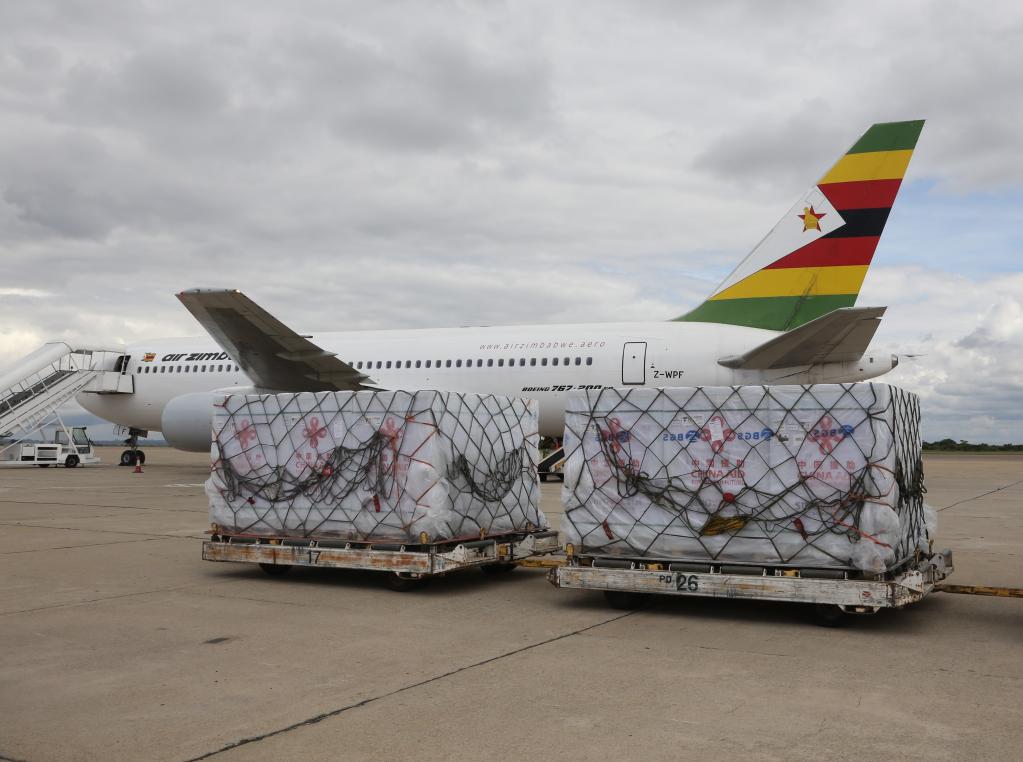
The file photo shows Zimbabwean President Emmerson Mnangagwa delivering a speech at the new parliament building in Harare, Zimbabwe, on Nov. 23, 2022. (Photo by Shaun Jusa/Xinhua)
China continued to spread its footprints across Zimbabwe in 2022, with major investments in infrastructure, mining, and industry taking place on a huge scale, further cementing bilateral relations.
HARARE, Dec. 31 (Xinhua) -- China continued to spread its footprints across Zimbabwe in 2022, with major investments in infrastructure, mining, and industry taking place on a huge scale, further cementing bilateral relations.
China has stood by the mantra "actions speak louder than words" and rallied behind the Zimbabwean government's efforts to uplift the livelihoods of its citizens.
While many projects were undertaken through platforms such as the Forum on China-Africa Cooperation (FOCAC), others were done through private enterprises attracted by the vast opportunities Zimbabwe presented.
A brand-new Parliament Building donated by the Chinese government through China Aid was completed during the year. The new Parliament Building, which is a combination of Chinese construction finesse and traditional Zimbabwean architecture and is nestled on a hill due north of Harare, the capital of Zimbabwe, will be officially handed over to the Zimbabwean government at a date yet to be announced.
Legislators, however, had their first feel of its comforts -- away from the congestion of the current building in the city center -- in November when President Emmerson Mnangagwa opened the last session of the current Parliament there.

The file photo shows Zimbabwean President Emmerson Mnangagwa (Rear) delivering a speech at the new parliament building in Harare, Zimbabwe, on Nov. 23, 2022. (Photo by Shaun Jusa/Xinhua)
China also remained the cornerstone of Zimbabwe's largely successful fight against COVID-19 by donating millions of doses of vaccines and providing protective clothing and ventilators. The vaccines were donated within the ambit of FOCAC.

The file photo shows a batch of COVID-19 vaccine donated by China arriving at Robert Gabriel Mugabe International Airport in Harare, Zimbabwe, on Dec. 20, 2021. (Xinhua/Zhang Yuliang)
As a result of the donations, Zimbabwe managed to contain the pandemic to a great extent, limiting the number of cases to under 260,000 infections and about 5,600 deaths since March 2020.
Mnangagwa also commissioned in Harare a new pharmaceutical warehouse also funded by China Aid, which has boosted the country's drug storage capacity.
Bilateral relations between China and Zimbabwe were raised to a comprehensive strategic cooperative partnership, further enhancing the win-win relationships that China espouses with its partners.
The expansion of Zimbabwe's largest airport -- the Robert Gabriel Mugabe International Airport -- is progressing under a concessionary loan provided by China Eximbank and is due for completion in 2023. The expansion, which is being done by China Jiangsu International, will allow the airport to grow its passenger handling capacity to about 6 million a year from the current 2.5 million.

The file photo, taken on Sept. 1, 2021, shows the construction site of the expansion project of Robert Gabriel Mugabe International Airport in Harare, Zimbabwe. (Photo by Wanda/Xinhua)
In mining, a life-changing development is taking place at Manhize in Mvuma, Midlands Province, where the 1-billion-U.S.-dollar Manhize Iron and Steel Plant is being set up by Dinson Iron and Steel Company (DISCO), a subsidiary of global steel producer Tsingshan Holding Group. This has set Zimbabwe on course to be one of the global leaders in steel production.
DISCO is slowly turning the once sleepy mining town of Mvuma into a modern one, with ancillary infrastructures such as housing, schools, health centers, and social amenities being developed. The integrated project encompassing mining, processing, and beneficiation will employ up to 6,000 workers and will also facilitate skills transfer as the resident Chinese engineers collaborate with local staff.
Around 14,000 other upstream and downstream jobs will be created from the project, which will initially produce about 600,000 metric tons of steel per year.
Production is projected to reach 5 million metric tons per year over time, thus contributing significantly to boosting the local economy and turning the country from being an importer to an exporter of iron and steel. According to trade promotion agency ZimTrade, Zimbabwe has been importing iron and steel products and their articles worth more than 300 million U.S. dollars per year.
Another major mining project being undertaken by Chinese investors is Huayou Cobalt's Arcadia Lithium Mine, just outside Harare, which is expected to start exports on a larger scale in 2023 with projections of earning 500 million U.S. dollars a year from 2 million U.S. dollars in 2017.
Zimbabwean economist Paul Musodza said Chinese investments were changing lives in countries fortunate to have attracted them.
"This year alone witnessed private Chinese investments pour into Zimbabwe on major mining and industrial projects worth millions of dollars. These short-term projects contribute strongly to the country's forex reserves. Some are long-term projects that are employing hundreds of Zimbabwean workers," he said in an interview. "It is in this regard that China wishes to work with the government of Zimbabwe in fully strengthening the financial services markets between the two countries to benefit both countries' industries."
While undergoing its own rejuvenation, China has pledged to make new contributions to humanity's well-being and continue to share new opportunities with the world.
Musodza said a wealthier China provided an expanded market for Zimbabwe and the world in general.
Information, Publicity and Broadcasting Services Minister Monica Mutsvangwa during the year also called for more cooperation between China and Zimbabwe anchored on FOCAC principles, noting that Zimbabwe found FOCAC to be the only viable way in the face of sanctions imposed on the country by the West.




 A single purchase
A single purchase









